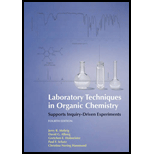
Interpretation:
The structure of every compound should be deduced along with the chemical shift of their carbon atoms by using additive parameters and NMR signals to their respective atoms should be assigned.
Concept Introduction:
Compounds consist of carbon and hydrogen is known as hydrocarbons. Hydrocarbons are classified as saturated hydrocarbon and unsaturated hydrocarbon. Saturated hydrocarbons are those hydrocarbons in which carbon-carbon single bond is present as carbon is linked with four atoms.
The compounds having similar chemical formula but different structures are known as isomers.
The compounds having similar chemical or molecular formula but different connectivity is known as constitutional isomers.
NMR stands for nuclear magnetic resonance is a technique which is used to characterize organic compounds by identifying frameworks of carbon-hydrogen within the compounds.
Want to see the full answer?
Check out a sample textbook solution
Chapter 23 Solutions
Laboratory Techniques in Organic Chemistry
- The following 1H NMR peaks were recorded on a spectrometer operating at 200 MHz. Convert each into δ units. (a) CHCl3; 1454 Hz (b) CH3Cl; 610 Hz (c) CH3OH; 693 Hz (d) CH2Cl2; 1060 Hzarrow_forward12D.15 At low resolution, the strongest absorption band in the infrared absorption spectrum of 12C¹6O is centred at 2150 cm-¹. Upon closer examination at higher resolution, this band is observed to be split into two sets of closely spaced peaks, one on each side of the centre of the spectrum at 2143.26 cm-¹1. The separation between the peaks immediately to the right and left of the centre is 7.655 cm-¹. Make the harmonic oscillator and rigid rotor approximations and calculate from these data: (a) the vibrational wavenumber of a CO molecule, (b) its molar zero-point vibrational energy, (c) the force constant of the CO bond, (d) the rotational constant B, and (e) the bond length of CO.arrow_forwardThe chemical shift of the CH3 protons in ethanal (acetaldehyde) is δ = 2.20 and that of the CHO proton is 9.80. What is the difference in local magnetic field between the two regions of the molecule when the applied field is (i) 1.5 T, (ii) 15 T?arrow_forward
- Sketch the appearance of the 1H-NMR spectrum of diethyl ether using J = 6.97 Hz in a spectrometer operating ati) 400 MHz. ii) 650 MHz. The chemical shift of the CH3 protons is 1.16 and that of the CH2 protons is 3.36.arrow_forwardthe figure shows a triplet signal from 1H NMR spectrum analysed on a 400 MHz NMR. Calculate the coupling constant (J) of this signal.arrow_forward2 PPM Calculate the coupling constant (J) for the multiplets reported in the 'H-NMR expansion above, knowing that the corresponding spectrum was recorded at 400 MHz. Report your result with four significant figures. 2.444 2.410 2.376 2.342 2.005 1 1.244 1.210 1.176 3.012arrow_forward
- The volatile organic compounds (VOCs) produced by decomposing tissue and organs were studied in an effort to identify possib human-specific markers (PLoS ONE 2015 10(9): e0137341.). Of 452 VOCs isolated, six were found to be unique to humans, so th prove to be a useful tool for forensic chemists trying to determine the source of unidentified remains. There are two doublets in expected ¹H NMR spectrum of the following human-specific VOC. Identify the protons giving rise to each doublet. 1 2 H3C H3C- оооооооо 238 H 8 HH HH 3 HH CH3 5 7 Identify the two groups of protons that give rise to the doublets in the spectrum. CH3 8arrow_forward10.9 A compound of molecular formula C₂H,CIO, has peaks at 55.8, 56.8, 112.9, 113.4, 116.2, 123.1, 149.5, and 153.9 in its proton- decoupled ¹3C NMR spectrum. Give the structure of the compound and assign as many signals as possible to the carbons in the structure.arrow_forward3. Identify C-Cl stretching peaks in CDC13 and CHC13 spectra. Do these peaks have exactly the same frequencies for both compounds? Explain your answer. 4. Is the C==O stretching frequency the same for acetone and deuterated acetone? Explain your answer. 5. Identify C==O overtone in acetone spectrum which corresponds to the transition from ground level, n=0, to the second excited level, n=2.arrow_forward
- In a 300 MHz NMR spectrometer, A) what is the Larmor frequency in MHz of a 15N nucleus? g H = N 26.752; g = 2.7126; B) Using the same NMR instrument, suppose that a 13C nucleus from a sample generates a signal which has a frequency of 11,250 Hz higher than that from the carbons in TMS. What is the chemical shift of that carbon atom from the sample? A) 30 MHz; B) 0.15 ppm OA) 25 MHz; B) 0.35 ppm A) 35 MHz; B) 0.30 ppm OA) 25 MHz; B) 0.55 ppmarrow_forwardComplete the spectroscopy data tables for a compound with molecular formula C6H14. Determine the structure of the compound. Any labile protons, if they exist, will not be present in this particular 1H NMR spectrum.arrow_forwardA student takes an IR spectrum of an unknown compound. The IR spectrum shows significant stretches at 3159 cm³¹ (m, sh), 3089 cm ¹ (m, sh), 3000 cm ¹ (m, sh), 2997 cm-¹ (m, sh), 1620 cm-¹ (s, sh), 1494 cm-¹ (s, sh), and 1210 cm-¹ (s, sh). Which possible compound is it? Key: S = Strong, M = Medium, W = Weak, Sh = Sharp, Br = Broad Anisole Aniline O Acetanilide O Acetone O Phenolarrow_forward
 Principles of Instrumental AnalysisChemistryISBN:9781305577213Author:Douglas A. Skoog, F. James Holler, Stanley R. CrouchPublisher:Cengage Learning
Principles of Instrumental AnalysisChemistryISBN:9781305577213Author:Douglas A. Skoog, F. James Holler, Stanley R. CrouchPublisher:Cengage Learning
 Organic ChemistryChemistryISBN:9781305580350Author:William H. Brown, Brent L. Iverson, Eric Anslyn, Christopher S. FootePublisher:Cengage Learning
Organic ChemistryChemistryISBN:9781305580350Author:William H. Brown, Brent L. Iverson, Eric Anslyn, Christopher S. FootePublisher:Cengage Learning Macroscale and Microscale Organic ExperimentsChemistryISBN:9781305577190Author:Kenneth L. Williamson, Katherine M. MastersPublisher:Brooks Cole
Macroscale and Microscale Organic ExperimentsChemistryISBN:9781305577190Author:Kenneth L. Williamson, Katherine M. MastersPublisher:Brooks Cole



